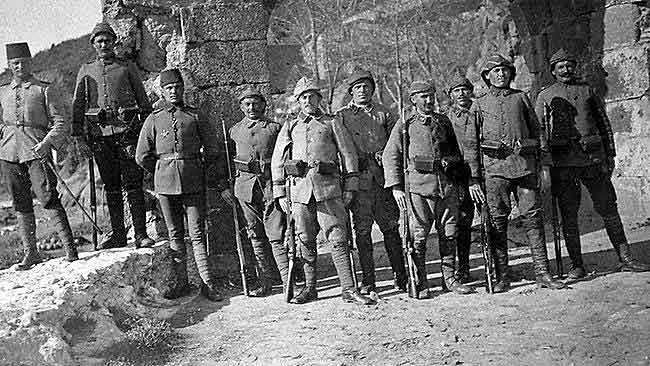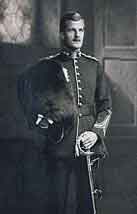Landings from the River Clyde at V Beach, with ‘6 VCs before breakfast’ at W Beach and the landing at Y Beach: British troops suffer heavy casualties at Cape Helles on Gallipoli, 25th April 1915 in the First World War

British troops landing from the River Clyde on 25th April 1915 during the first landings on V Beach, Cape Helles: Gallipoli, 25th April 1915 in the First World War: picture by Charles Dixon
The previous battle of the First World War is Gallipoli Part III: ANZAC landing on 25th April 1915
The next battle of the First World War is Battle of Jutland Part I: Opposing fleets
The Dardanelles and Gallipoli: The campaign during 1915 conducted by the British and the French, using British, French and Australian warships and British, French, Australian, New Zealand and Indian troops, to take the Gallipoli Peninsular, penetrate the Dardanelles waterway and capture Constantinople, thereby knocking the Ottoman Turkish Empire out of the First World War.
Date: March 1915 to January 1916
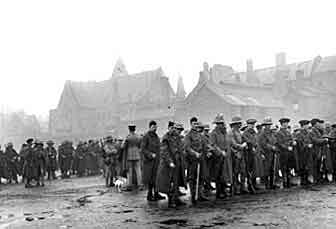
1st Royal Munster Fusiliers in Coventry on 11th January 1915 before leaving for Gallipoli as part of the 29th Division and landing on V Beach Cape Helles from the collier River Clyde on 25th April 1915
Place: The Gallipoli Peninsular forms the northern shore of the Dardanelles, the narrow waterway leading from the north east corner of the Aegean Sea to the Sea of Marmora, the city of Constantinople (in 1915 the capital of the Ottoman Turkish Empire) and then to the Black Sea.
War: The First World War also known as ‘The Great War’.
Contestants: British, Australian and New Zealand troops with French troops supported by British and French naval ships against Turkish troops and ships led by German senior officers.
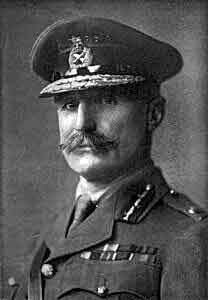
Lieutenant General Sir Aylmer Hunter-Weston GOC of 29th Division and in command of the landings on Cape Helles Gallipoli on 25th April 1915
Generals: General Sir Ian Hamilton led the Entente (British, French, Australian, New Zealand and Indian) troops until he was replaced by General Sir Charles Munro in October 1915. General Eric Liman von Sanders, a German officer, commanded the Turkish troops. Vice-Admiral de Robeck commanded the British fleet. Admiral Guépratte commanded the French warships.
General d’Amade commanded the French troops. Major General Birdwood commanded the Australian and New Zealand Army Corps (ANZAC) Major General Hunter-West commanded the British 29th Division. Major General Paris commanded the Royal Naval Division.
Winner: The final outcome was that the Entente Allies, Britain and France, withdrew from the Gallipoli Peninsular between December 1915 and January 1916 leaving the Turks victorious.
Part IV: The first landings at Cape Helles and Y Beach on 25th April 1915
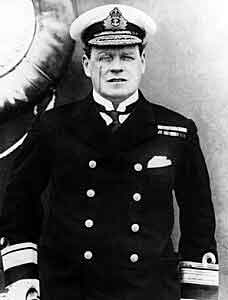
Rear Admiral Rosslyn Wemyss in command of the Royal Navy ships supporting the British landings at Cape Helles Gallipoli on 25th April 1915
While the ANZAC Corps attacked north of Gaba Tepe with the aim of cutting across the Gallipoli Peninsular half way up its length, the two British divisions would attack at Cape Helles (Cape Helles is the main promontory in the centre of the two mile wide southern end of the Gallipoli Peninsular).
It was decided to make a further landing at what was expected to be a deserted beach further north and level with Krithia, ‘Y’ beach.
The French division would carry out a diversionary attack on the Asiatic shore.
The main force for the initial British landings was the 29th Division formed almost entirely of regular British infantry battalions brought back from colonial postings following the declaration of war on 3rd August 1914. Two Royal Naval Division battalions were attached to the 29th Division for the initial landings; Plymouth Battalion RMLI and Anson Battalion.
Five beaches around Cape Helles were to be attacked: X Beach situated on the north west coast of the Cape Helles promontory: W Beach on the western section of the southern coast between Tekke Burnu and Cape Helles: V Beach at the eastern end of the cove lying between Cape Helles and Sedd el Bahr: Camber Beach lying round the south-eastern promontory of Sedd el Bahr and S Beach at De Totts Battery at the eastern end of the sweep of Morto Bay.
General Sir Ian Hamilton’s plan for Cape Helles followed the form of the ANZAC landing: a covering force landing first, followed by the main body once circumstances permitted the disembarkation of more troops.
The size of the covering force was governed by the naval resources available to put it ashore and the amount of space on-shore in which the troops could operate.
The force landing on X, W, V and Camber beaches was the 86th Fusilier Brigade commanded by Brigadier General Hare comprising 2nd Royal Fusiliers (to land on X Beach), 1st Lancashire Fusiliers (to land on W Beach), 1st Royal Munster Fusiliers (to land on V Beach from the River Clyde) and 1st Royal Dublin Fusiliers (to land on V Beach) with an additional two companies from 2nd Hampshires (to land on V Beach from the River Clyde) and four platoons from the Anson Battalion split between the various units.
2nd South Wales Borderers was to land on S Beach. Signallers, engineers and medical personnel were attached to the detachments.
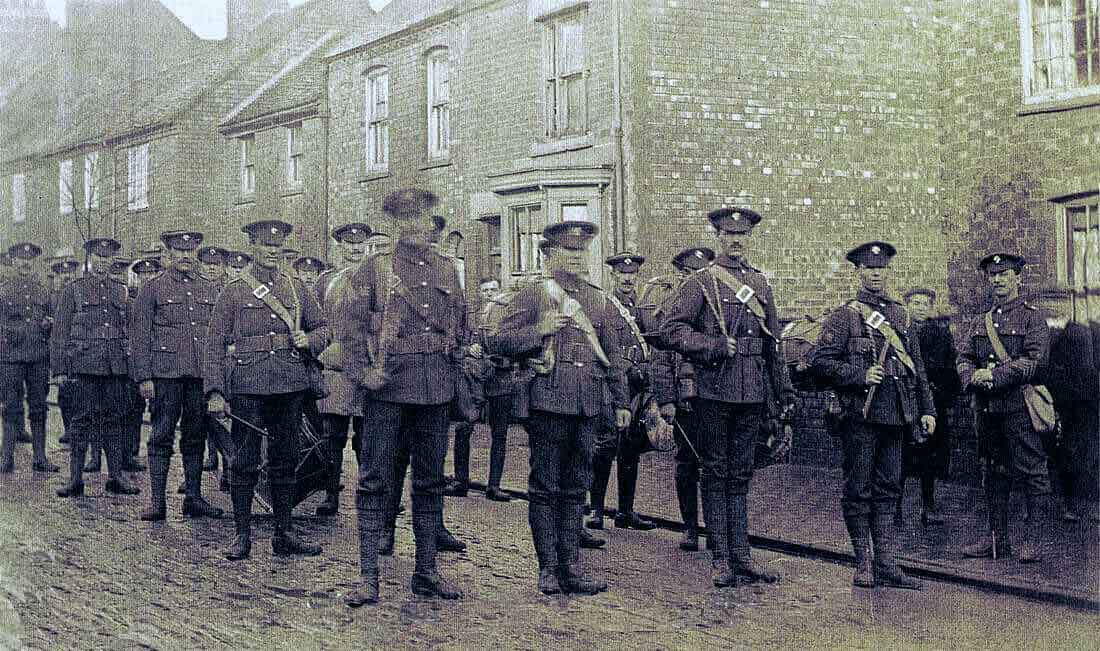
Drums of 2nd Royal Fusiliers in Stockingford Warwickshire in January 1915 before leaving for Gallipoli and landing on X Beach Cape Helles 25th April 1915
1st King’s Own Scottish Borderers (KOSB) and the Plymouth Battalion Royal Marine Light Infantry with one company of 2nd South Wales Borders was to land on Y Beach.
The covering force (X, W, V, Camber and S Beaches) was to approach the Gallipoli coast in naval warships and then transfer to tows for the final passage to land.
The warships carrying the covering force to its disembarkation point were HMS Implacable (X and part of W Beaches), HMS Euryalus (W Beach), Fleet Sweeper No 1 and the River Clyde (V and Camber Beaches) and HMS Cornwallis (S Beach).
Supporting units with two companies of 2nd Royal Fusiliers were to come up in other craft.
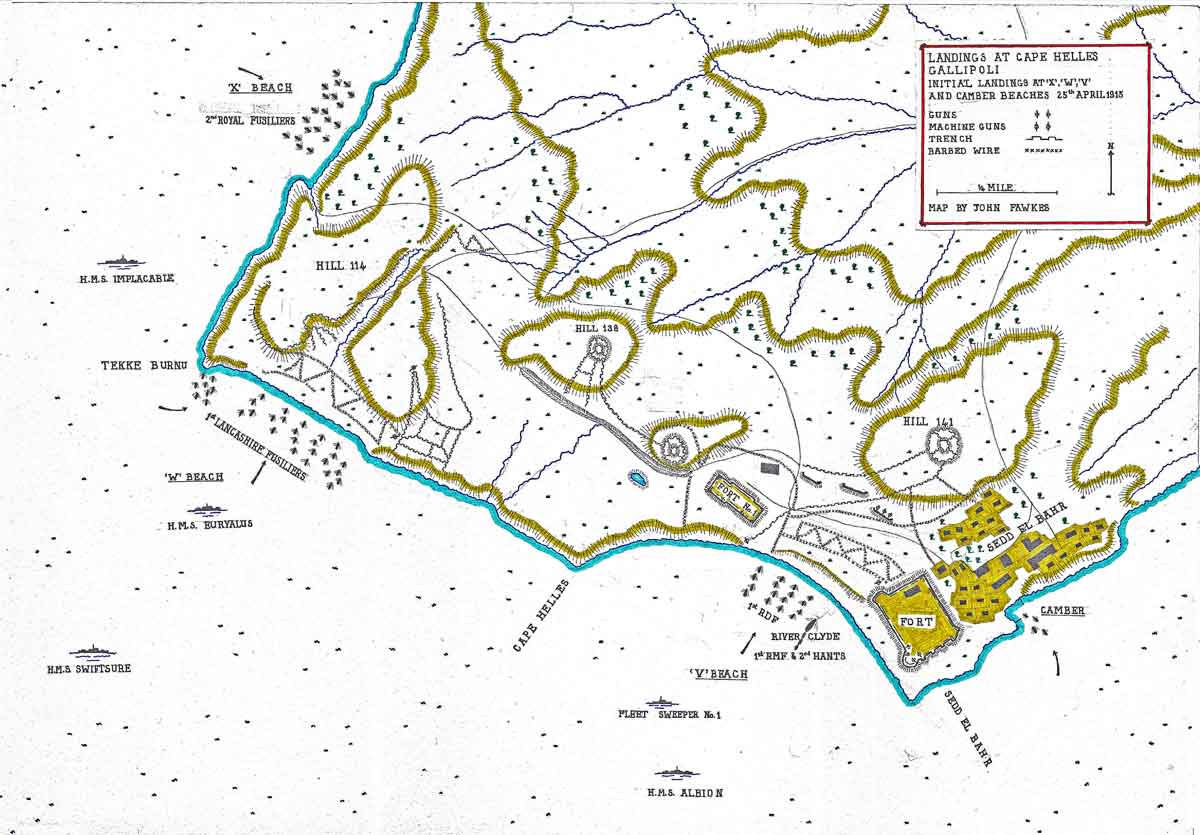
Map of the initial landings on 25th April 1915 at ‘X’, ‘W’, ‘V’ and Camber beaches, Cape Helles, Gallipoli, : map by John Fawkes
The expectation was that once ashore the various units would link up and form a complete brigade line.
As at Anzac it was the intention of the army command to make the landing at night. In the case of Cape Helles the naval commanders refused, siting the strong currents and the difficulty of manoeuvring ships in such a confined space, and the landing was fixed for daylight.
The operation would begin with a naval bombardment of the shore defences at 5am: HMS Albion on V Beach, HMS Swiftsure and Euryalus on W Beach and HMS Implacable on X Beach.
At 5.30am the bombardment would end and the troops set off for the beaches in tows, each comprising a steamboat pulling a string of four ship’s boats. The ship’s boats would be cast adrift and rowed the final section to shore.
These boats were wooden and provided no protection for the troops aboard even against rifle fire.
The three companies of 2nd South Wales Borderers were to transfer from HMS Cornwallis to three trawlers and enter Morto Bay ready to land on S Beach as the tows set off for the other beaches.
It was planned that the covering force would be ashore by 7am, the landing of the main force would begin by 8.30am and the whole of the 29th Division infantry with much of its artillery be ashore by midday.
W Beach was to be reserved for the landing of guns, horses, transports and stores due to its ease of access to the hinterland and its reduced vulnerability to gunfire from the Turkish positions on the Asiatic shore.
As the landing proceeded a substantial naval force was to bombard identified Turkish infantry and gun positions further inland. This naval force was commanded by Rear Admiral Nicholson and comprised the ships conducting the initial bombardment with the addition of HMS Queen Elizabeth (once it returned from the Anzac landing), Vengeance, Lord Nelson, Prince George, Albion, Swiftsure, Dublin, Goliath, all battleships, and the cruisers Sapphire, Amethyst, Talbot and Minerva.
Aims of the covering force:
Once the groups at the beaches had linked up the 86th Brigade was to establish a line across the isthmus from X Beach to Sedd el Bahr to cover the landing of the main force.
On landing Major General Hunter-Weston, the commander of 29th Division, would take command of all the troops ashore and press on to take the final objective for the day, the Achi Baba Ridge and the ground running down to the Dardanelles coast line.
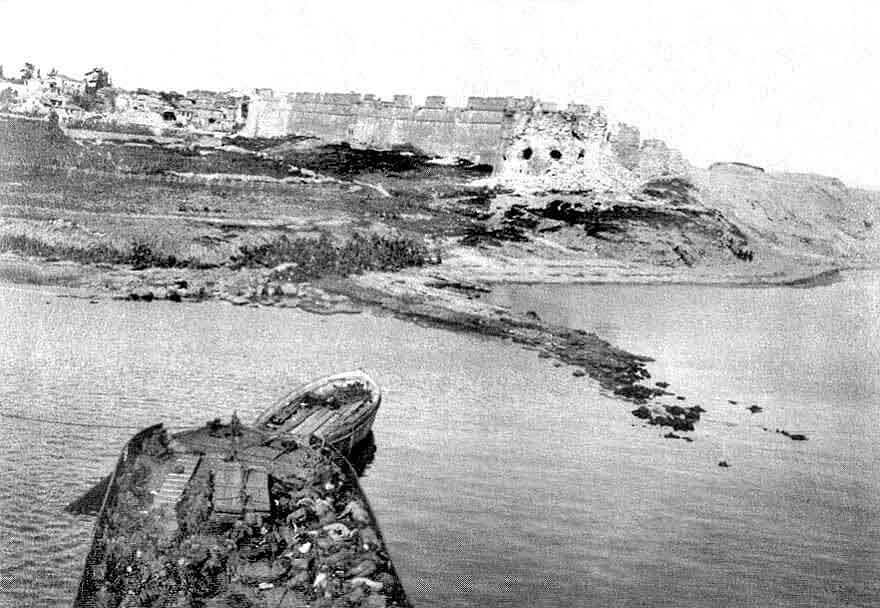
Fort of Sedd el Bahr at the eastern end of V Beach Cape Helles Gallipoli seen from the bridge of the River Clyde with the bow machine gun position in the foreground
As at Anzac the objectives set for the first day of the landing demonstrate the extent to which the British commanders underestimated the difficulties of the ground, the strength of the defences and the competence of the German trained Turkish infantry and artillery. The lack of trained air observers for the British aircraft meant that there was no proper assessment from the air of the nature of the countryside which proved to be more broken and difficult than was reported.
Achi Baba was not taken by the British and French troops at any time in the eight month Gallipoli campaign.
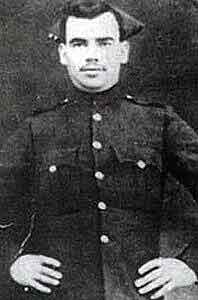
Private Bleakley 1st Lancashire Fusiliers won the Victoria Cross for his conduct in the landing on W Beach Cape Helles Gallipoli on 25th April 1915 (one of the ‘six VCs before breakfast’ won by the battalion)
Turkish Troop Dispositions at Cape Helles:
The British over-estimated the strength of the Turkish forces at Cape Helles. It was believed that the whole of the Turkish 9th Division was positioned in the area. In fact only two battalions and one company of engineers were south of Achi Baba.
Actually on the beaches there were two companies covering W and V Beaches. At S Beach there was one platoon. At X Beach there were twelve Turkish infantrymen.
Only W and V Beaches were protected by barbed wire and machine guns.
The Covering Force:
The ships carrying the covering force left the island of Tenedos at 10pm on 24th April 1915, timed to arrive off Cape Helles an hour before daylight.
At 3.30am the warships were in place off each beach and at 4 am the troops transferred from the ships to the tows. The first wave was in eighteen tows, each comprising a steam launch pulling four wooden boats. Brigadier General Hare determined to land at the earliest opportunity travelled in the first wave for W Beach.
To the south HMS Cornwallis was heading for Morto Bay with the troops for S Beach in four trawlers.
A mile behind were the transports carrying the troops of the covering force second trip, including the River Clyde.
Further south were the eleven transports carrying the remainder of the 29th Division.
The 29th Division commander General Hunter-Weston was on board the British frigate HMS Euryalus, to ensure the best of communications with Rear-Admiral Wemyss.
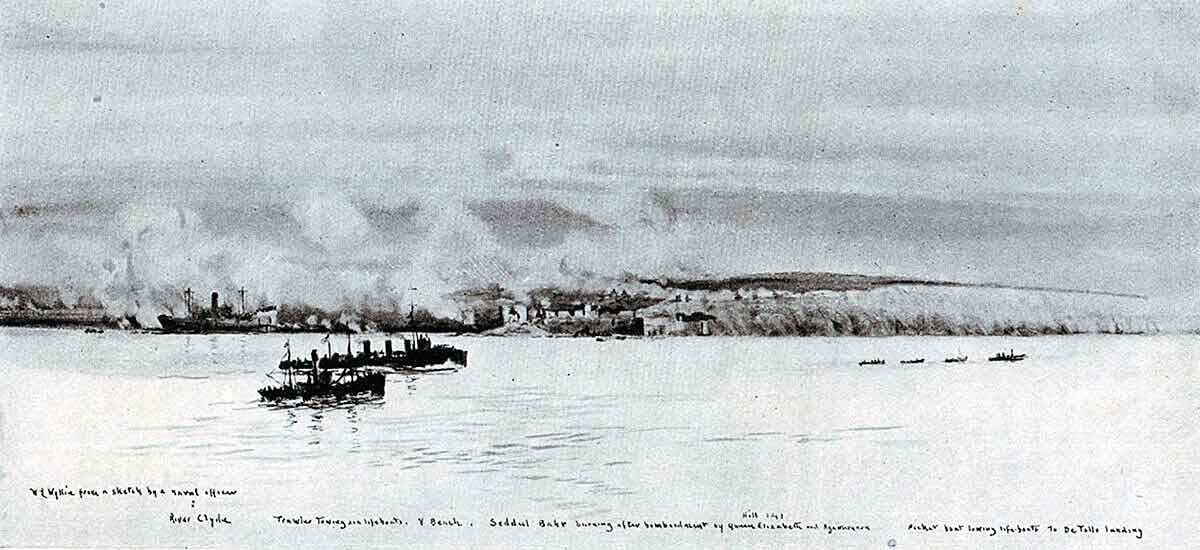
River Clyde, with Sedd el Bahr burning, on 25th April 1915 during the first landings on V Beach, Cape Helles: Gallipoli, 25th April 1915 in the First World War: picture by Lionel Wyllie
At 5am the warships began the bombardment of the beach areas. While bringing a substantial number of guns to bear the naval gunfire had significant limitations. Naval guns have a flat trajectory, not appropriate for engaging land targets where a lobbing trajectory is needed to put the shell into the position under fire. The warships were equipped with the standard ship to ship ammunition which was armour piercing. High explosive shells were needed to destroy field fortifications. A direct hit with armour piercing shot was required to destroy a field gun.
Half an hour later the troops were to land on each of the four beaches simultaneously. The flotilla of four trawlers heading for S Beach encountered unexpectedly strong currents and were delayed.
X Beach landing:
X Beach is two hundred yards long at the bottom of a cliff. The only Turkish presence was a twelve man picket. There were no barbed wire obstacles nor machine guns
At 6am the troops, 2nd Royal Fusiliers and one company of 1st Lancashire Fusiliers, with the brigade commander Brigadier General Hare headed for the shore in five tows under the covering fire of HMS Implacable.
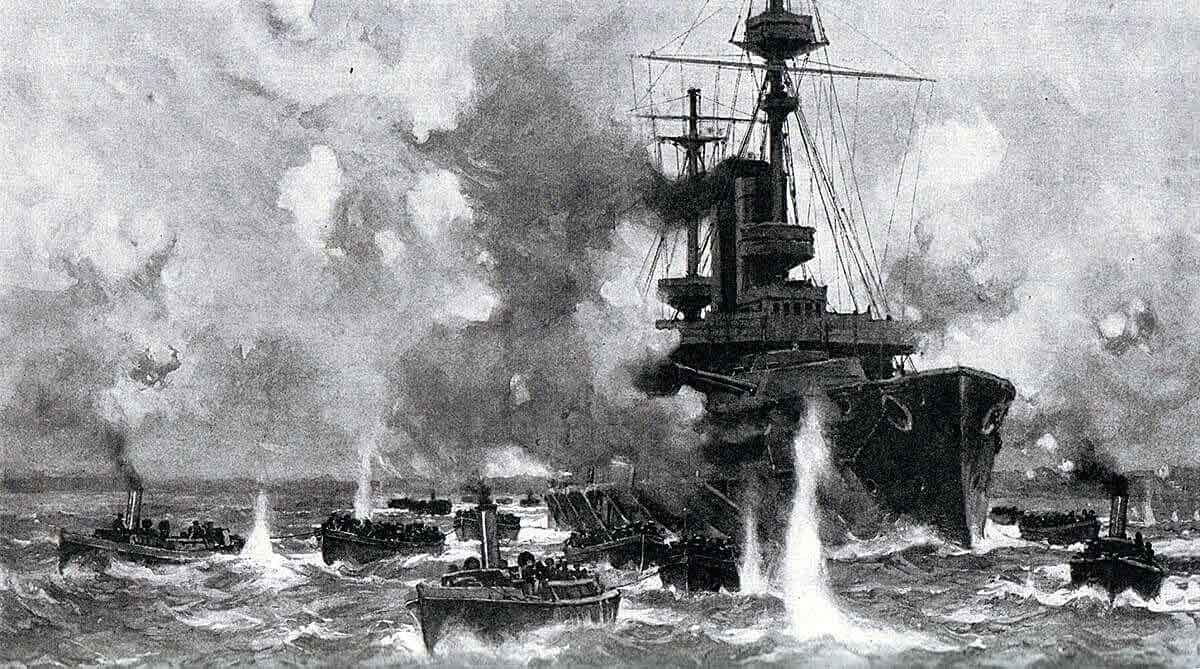
HMS Implacable on 25th April 1915 disembarking troops for X and W Beaches during the Cape Helles landings on Gallipoli
By 6.30am two companies of 2nd Royal Fusiliers with their machine guns were ashore and at the top of the cliff without suffering a casualty. They were followed by the rest of the battalion by 7.30am.
The commanding officer of 2nd Royal Fusiliers sent one company to the high ground to the north-east and, leaving another company in the beach area, moved south-west at 8am with one and a half companies to attack the Turkish positions on Hill 114 between X and W Beaches. Hill 114 was taken by 11am.
Captain Leslie leading the company to the north-east met strong resistance and was held up.
The editor of the Official History points out that the cliffs above X Beach provided a view over the whole of the Cape Helles area which the landing force could have exploited if it had been realised. In the early stages the Gallipoli expedition was dogged by the lack of advance knowledge of the ground and of reliable maps.
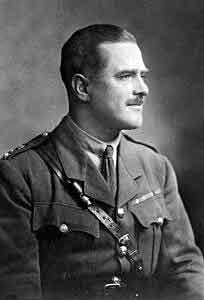
Captain Willis 1st Lancashire Fusiliers won the Victoria Cross for his conduct in the landing on W Beach Cape Helles Gallipoli on 25th April 1915 (one of the ‘six VCs before breakfast’ won by the battalion)
W Beach landing:
The area for this landing comprised a sandy beach 350 yards long and 15 to 40 yards wide backed by steep cliffs broken in the middle by a long gully heading inland.
The Turkish troops had put considerable effort and ingenuity into fortifying the area. A wide barbed wire belt lay along the waterline with mines on the beach. They had dug trenches on the cliff tops and on the high ground on each flank of the beach and concealed several machine guns in the cliffs covering the wire entanglement. There were two redoubts on Hill 138 to the south-east of the bay, one of which overlooked W Beach. Only one company of infantry manned these defences but the attackers faced a formidable task landing in wooden craft.
At 6am a row of six tows headed off from HMS Euryalus with two further tows from HMS Implacable slightly behind to their left carrying 1st Lancashire Fusiliers and heading for various parts of W Beach: A, B companies and the machine guns to attack the Turkish trenches and redoubt on Hill 138 on the right, C Company to attack the Turkish trenches overlooking the beach. Two platoons with the remainder of D Company and the HQ were to land under Tekke Burnu at the western tip of the bay as the battalion reserve.
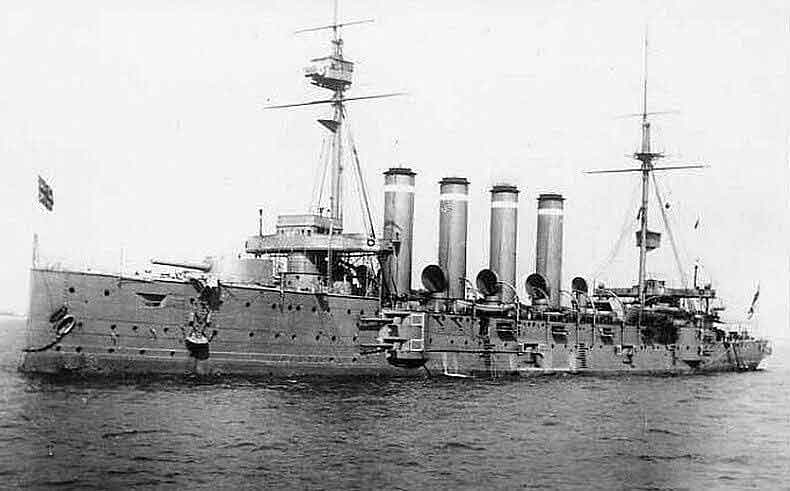
British cruiser HMS Euryalus the warship carrying troops of 2nd Lancashire Fusiliers to W Beach Cape Helles Gallipoli 25th April 1915
The boats were cast adrift from the towing steam launches fifty yards from shore, the naval crews rowing the final distance. Simultaneously the warships ceased firing enabling the Turkish troops to show their heads above the trench parapets.
As the boats reached the shore the Turkish troops opened fire with rifles and machine guns immediately inflicting heavy loss. The Lancashire Fusiliers rushed ashore to find that the naval bombardment had had no effect on the wire entanglement (destruction of wire required high explosive shells with which the Royal Navy was not equipped).
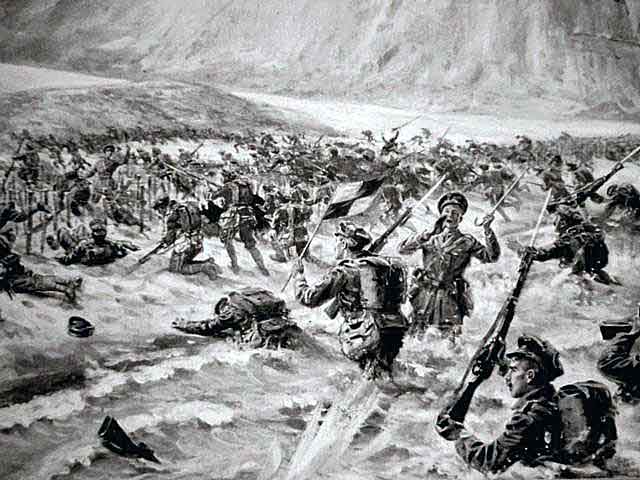
1st Lancashire Fusiliers landing on W Beach Cape Helles Gallipoli on 25th April 1915 winning ‘six Victoria Crosses before breakfast’
Parties of Lancashire Fusiliers forced their way through the barbed wire and captured the Turkish trenches overlooking the centre of the beach.
Brigadier General Hare following the first line of tows directed the boats from HMS Implacable to a ledge at the northern end of W Beach, where they could land unseen, and from there captured the Turkish trench at the end of the line.
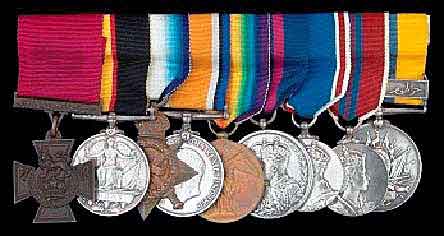
Medals of Captain Willis who won the Victoria Cross at W Beach Cape Helles Gallipoli on 25th April 1915: Victoria Cross, Queen’s Sudan Medal (1896-98), 14-18 Star, British War Medal, Victory Medal, Delhi Durbar Medal, King George VI Coronation Medal, Queen Elizabeth II 1953 Coronation Medal, Khedive’s Sudan Medal (1896-1908) with clasp ‘Khartoum’ in Arabic
More troops on the beach were finding their way through the wire and on the right A Company stormed up onto the cliff. Unfortunately a misdirected naval shell exploded among the British troops knocking them back onto the beach.
By 7.15am a line was being held which secured the landing area of W Beach.
On the left Brigadier General Hare with his brigade major and signallers pushed on up Hill 114 to establish contact with the Royal Fusiliers from X Beach. Hare was severely wounded by Turkish fire from the positions on the hill.
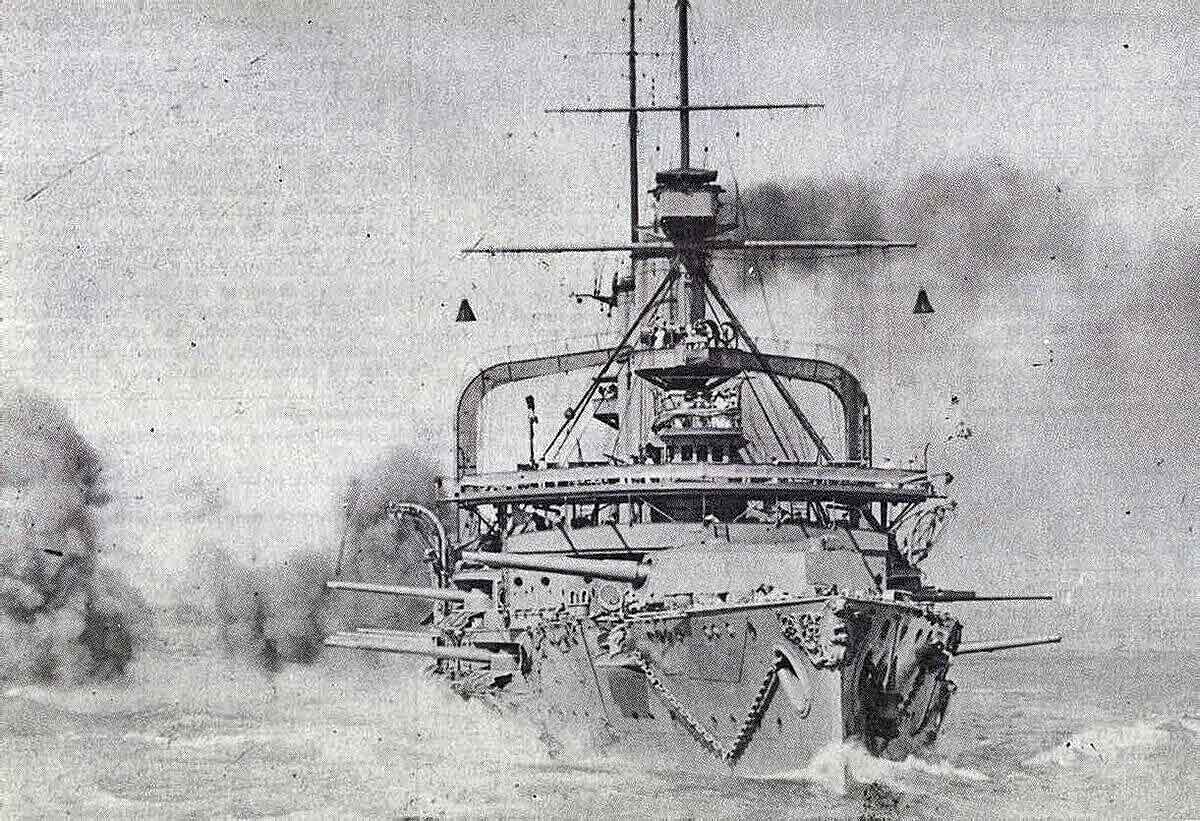
HMS Swiftsure in action: the British pre-Dreadnought battleship supported the landing at W Beach Cape Helles Gallipoli on 25th April 1915
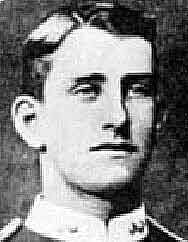
Sergeant Stubbs 1st Lancashire Fusiliers won the Victoria Cross for his conduct in the landing on W Beach Cape Helles Gallipoli on 25th April 1915 (one of the ‘six VCs before breakfast’ won by the battalion)
Command of 86th Brigade now devolved on Lieutenant Colonel Newenham commanding officer of 1st Royal Fusiliers at X Beach. The signal informing Newenham went through Implacable. Soon afterwards Newenham himself was badly wounded. At a critical juncture in the operation the troops ashore were deprived of their higher command.
The brigade major went to the southern end of the beach to organise the attack on the Hill 138 redoubt with troops from the second landing. The approach to Hill 138 was about half a mile along the coast from W Beach. Unknown to the British there was a further redoubt on additional high ground not shown on their maps.
The British attack was held up by the two redoubts and the brigade major killed.
At the western end of the beach the Lancashire Fusiliers were advancing to meet the Royal Fusiliers from X Beach and in the centre they were clearing a way up the central gully.
In the course of the day’s fighting 1st Lancashire Fusiliers suffered casualties of 11 officers and 698 soldiers.
Victoria Crosses from the W Beach landing:
The Lancashire Fusiliers won six Victoria Crosses from the fighting to land on W Beach. The VCs were awarded to Captain Bromley, Captain Willis, Sergeant Stubbs, Sergeant Richards, Lance Corporal Grimshaw and Private Kenealy and gave rise to the army aphorism “the Lancashire Fusiliers at Gallipoli won six VCs before breakfast”.
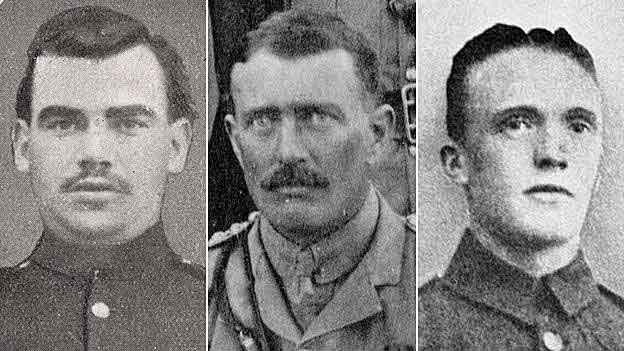
Private Kinealy Captain Bromley and Corporal Grimshaw 1st Lancashire Fusiliers won the Victoria Cross for their conduct in the landing on W Beach Cape Helles Gallipoli on 25th April 1915 (three of the ‘six VCs before breakfast’ won by the battalion)
V Beach Landing:
V Beach occupied the eastern half of the bay that lies between Cape Helles, the headland to the south of Hill 138, and the old fort and hamlet of Sedd el Bahr at the eastern end of the bay.
In the western half of the bay precipitous cliffs come down to the waterline restricting access from the sea.
Overlooking the western end of the beach was the old Fort No 1 on the cliff.
The ground behind V Beach slopes inland. The beach itself is 300 yards long and10 yards wide backed by a bank about 5 feet high. In spite of the ambitious plans of the higher command the troops of the covering force were to get no further than the 5 foot bank and were thankful that it was there to provide them with cover.
Fort No. 1 at the western end of V Beach and the fort and buildings of Sedd el Bahr had been bombarded by the British and French warships during the March 1915 naval attack on the Dardanelles and again on the morning of the landings. The bombardments had left the buildings severely battered and without any of the guns originally emplaced there but, if anything, the damage to the walls made them a stronger field fortification for infantry overlooking the landing beach.
The Turkish army had reinforced these fortifications with trenches and a barbed wire entanglement along the top of the beach from Sedd el Bahr to Fort No.1. There was a further wire entanglement halfway up the slope behind the beach and a third along the western side of Sedd el Bahr village.
Machine guns were positioned in the forts at each end of the beach and others in the more central trenches. On the left end of the ridge there were two Pom Pom quick firing guns.
So strong were the Turkish defences at V Beach that the official historian states that the senior British officers, who were aware of the work the Turks were carrying out, must have assumed that they would be destroyed by the naval bombardment on 25th April 1915 before the landings.
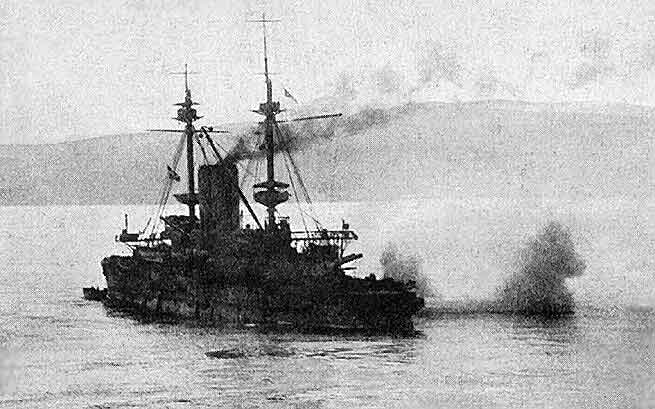
British battleship HMS Albion in the Dardanelles. Albion provided the support for the landings on V Beach Cape Helles Gallipoli on 25th April 1915
HMS Albion fired on the shore defences for half an hour doing considerable damage to the buildings. The Turkish trenches were not damaged. Again the limitations on naval ammunition will have been a factor as will the flat trajectory of the naval guns eliminating the ‘howitzer’ effect essential effectively to shell field fortifications.
It was expected that the Sedd el Bahr position would be eliminated by the half company landing on the far side of the point and attacking the position in the rear.
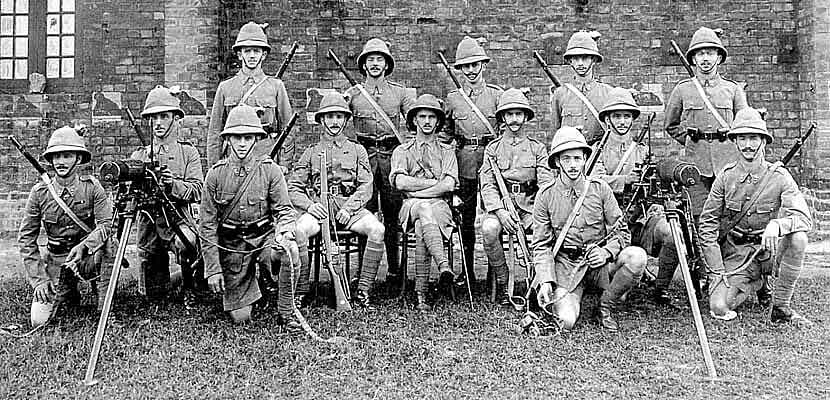
1st Royal Munster Fusiliers machine gun section commanded by Captain Dorman (seated in centre) in India in 1914. 1st Royal Munster Fusiliers landed from the River Clyde on V Beach Cape Helles Gallipoli on 25th April 1915
As at all the beaches the naval bombardment ceased once the landing boats neared the shore leaving a period of around ten minutes for the Turkish troops to re-occupy their positions, abandoned to take cover from the shell-fire.
The five tows for V Beach and the one for Camber around the point set off from the ships just before 6am with 1st Royal Dublin Fusiliers and the platoon of the Anson Battalion.
The plan was that the River Clyde would be grounded near the shore shortly after the rowed barges reached the beach.
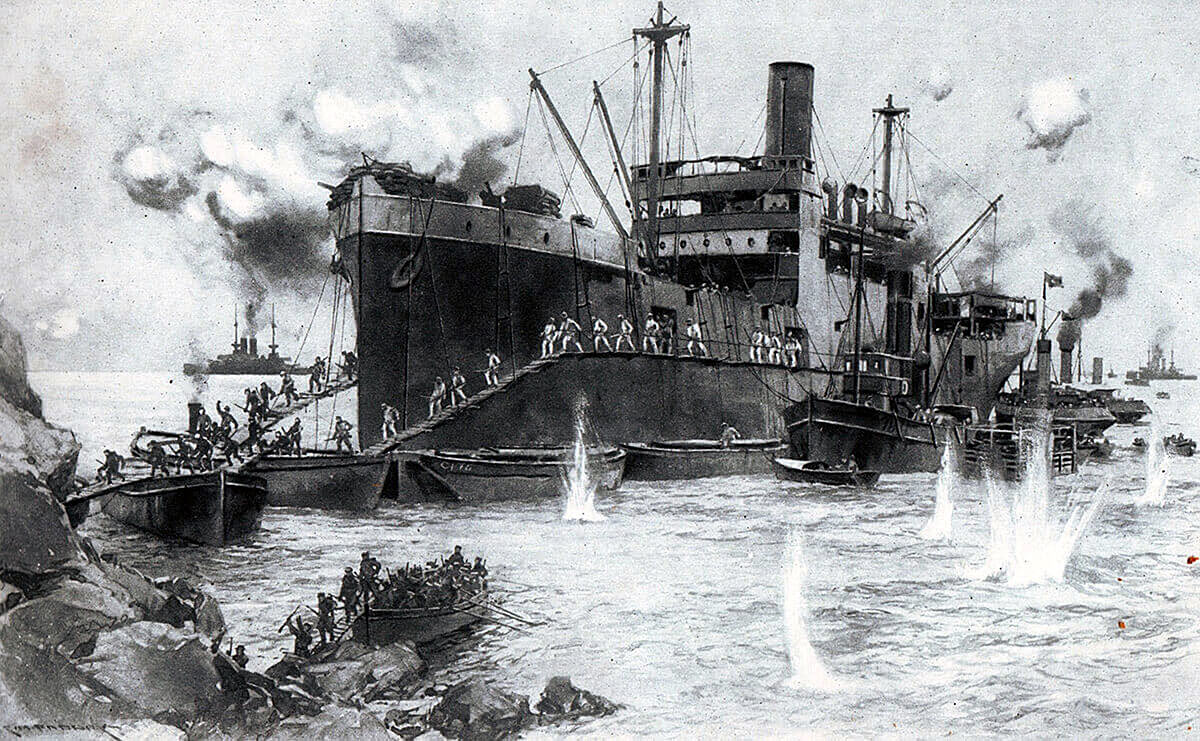
British troops landing from the River Clyde on 25th April 1915 during the first landings on V Beach, Cape Helles: Gallipoli, 25th April 1915 in the First World War
As at several other locations in the Gallipoli landings the tows encountered an unexpected current and were delayed, falling behind the more powerful River Clyde. As the River Clyde was required to ground after the tows had landed she was forced to change course to give the tows time to catch up.
There was at this stage no fire from the shore. The growing expectation was that the Turks had decided not to oppose the landing and had gone.
The River Clyde ran ashore at the point planned. Lieutenant Colonel Williams on the River Clyde recorded in the log he was jotting down as the operation progressed: “6.22am Ran smoothly ashore without a tremor. No opposition. We shall land unopposed.”
Three minutes later Colonel Williams wrote: “6.25am. Tows within a few yards of shore. Hell burst loose on them. One boat drifting to north, all killed. Others almost equally helpless. Our hopper gone away.”
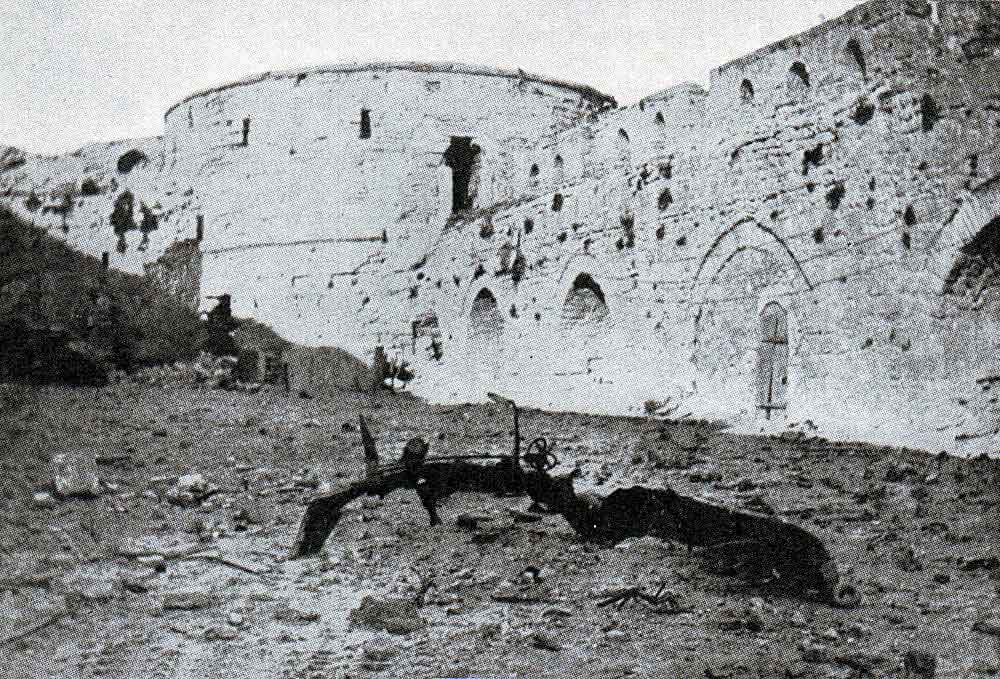
Old Fort at Sedd el Bahr forming the eastern part of the Turkish defences at V Beach Cape Helles Gallipoli on 25th April 1915
The Official History states: “Up to the last moment it seemed that the Turkish defences had been abandoned; but just as the River Clyde grounded, and when the boats were only a few yards from the shore, Hell was suddenly let loose. A tornado of fire swept over the incoming boats, lashing the calm waters of the bay as with a thousand whips. Devastating casualties were suffered in the first few seconds. Some of the boats drifted helplessly away with every man in them killed. Many more of the Dublins were killed as they waded ashore. Others, badly wounded, stumbling in the water, were drowned. Those who succeeded in crossing the strip of sand, managed to gain a precarious shelter under the bank on the further side.”
It was intended that the boats that had landed the covering party on V Beach would return to the transports and convey the main body to the shore. The boats were almost entirely destroyed and their naval crews killed.
The two platoons landed at Camber around the point from the main V Beach landing, but all the officers were killed and the troops pinned down, the few men who got into the village being captured by the Turks.
The River Clyde:
During the planning for the landings on Gallipoli in April 1915 Commander Unwin, captain of the destroyer HMS Hussar, put forward a plan for landing a significant number of soldiers with cover provided right up to the beach. A collier would be filled with around 2,000 troops and run ashore immediately after the first wave of troops landed.
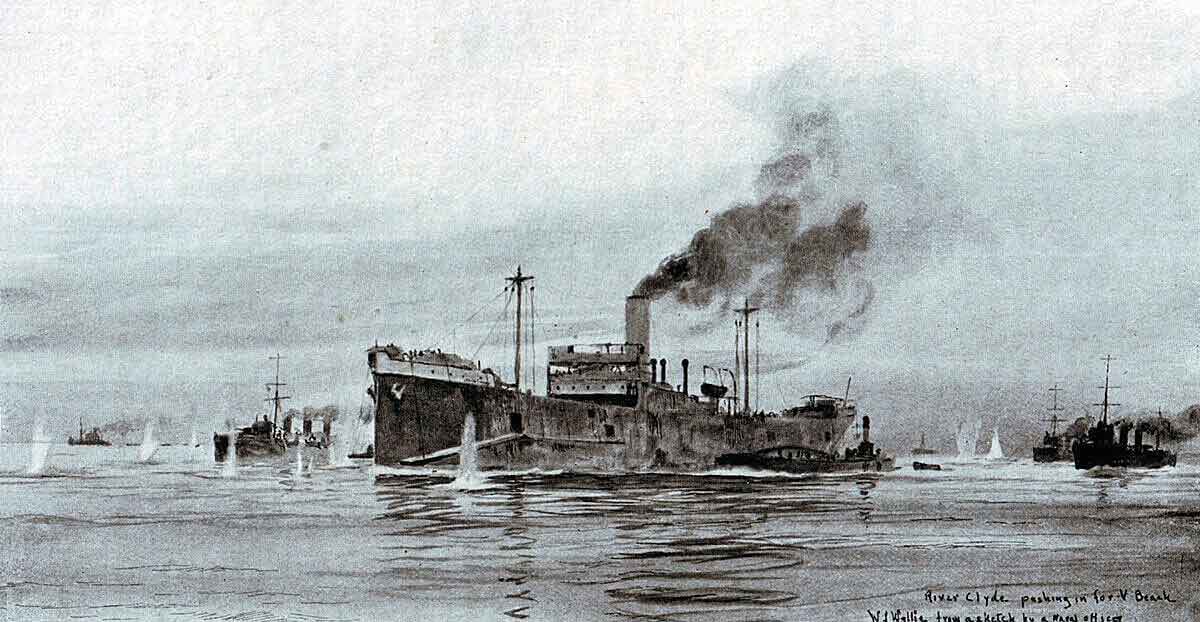
River Clyde pushing in for V Beach during the landings at Cape Helles on Gallipoli 25th April 1915: picture by Lionel Wyllie
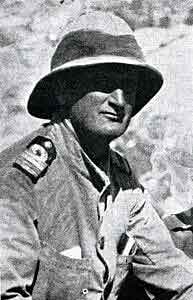
Commander Unwin proposer of the scheme to use the collier River Clyde in the V Beach landings at Cape Helles on Gallipoli and captain of the collier. Commander Unwin was awarded the Victoria Cross for his conduct on 25th April 1915
Unwin’s plan was adopted and Unwin was given command of the selected collier, the River Clyde. Unwin spent the short period left in adapting the River Clyde for her role. Holes were cut in the collier’s sides and gangways attached so that the troops could remain in cover until the last moment and then emerge from the ship and run down the gangways to a platform under the bows.
Unwin arranged a system of lighters which would be towed to the shore and then swung round to the front of the collier to provide a bridge to the shore.
A battery of machine guns was placed in the bow of the collier, protected by sandbag walls, to provide covering fire for the landing troops.
On 25th April 1915 the River Clyde carried 1st Royal Munster Fusiliers, 2nd Hampshire Regiment (less two companies), one company of Royal Dublin Fusiliers and other sub-units of signallers and engineers. Several senior staff officers were on the collier including Lieutenant Colonel Williams.
When the River Clyde grounded one of the craft intended for the bridge became stuck in the wrong place. Unwin, accompanied by Able Seaman Williams, plunged into the sea and hauled the lighters into place between the collier and the shore providing the bridge needed for the heavily encumbered infantrymen to disembark.
All the while the machine guns in the bows of the River Clyde provided a heavy covering fire for the landing.
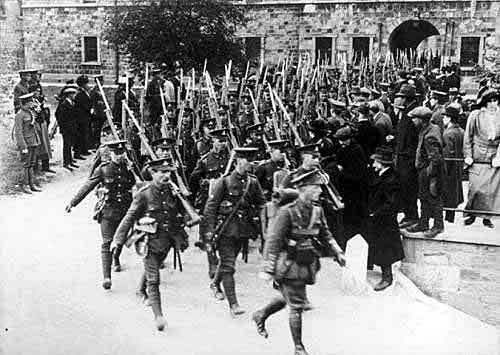
1st Royal Dublin Fusiliers leaving barracks in Dublin for Gallipoli as part of the 29th Division, landing on V Beach Cape Helles on 25th April 1915
The Munster Fusiliers poured down the two gangplanks to cross the lighters to the shore. Virtually all of the first companies were shot down by the murderous Turkish fire from the shore.
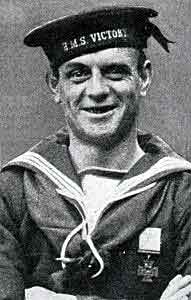
Able Seaman Mackenzie Samson of HMS Hussar awarded the Victoria Cross for his conduct as a crew member of the River Clyde at V Beach Cape Helles Gallipoli 25th April 1915
Able Seaman Williams was killed by a shell burst fired by a Turkish gun on the Asiatic coast and, Unwin being unable to hold the lighter in position on his own, it drifted out of place.
The Munsters continued trying to reach the shore struggling through the intervening water. Many were shot and others dragged down by their heavy equipment and drowned.
As they scrambled ashore the surviving Munsters and Dubliners gathered at the five foot bank. Some soldiers went on and attempted to cut their way through the wire entanglement but were shot.
Lieutenant Colonel Williams on the River Clyde noted that the Turkish rifle fire was “extraordinarily well handled ….. very heavy and accurate.”
The decision was taken that no further troops, in particular the two companies of 2nd Hampshires, would attempt to land from the River Clyde until after dark.
By 9am the survivors of the 1st Royal Dublin Fusiliers and 1st Royal Munster Fusiliers lay in cover under the bank at the top of the beach unable to move in the face of the heavy rifle and machine gun fire from the defending Turkish troops, albeit only one company.
Victoria Crosses from the River Clyde:
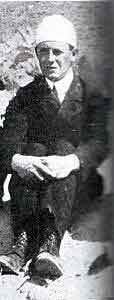
Midshipman Drewry awarded the Victoria Cross for his conduct as a crew member of the River Clyde at V Beach Cape Helles Gallipoli 25th April 1915: see reference to biography by Quentin Falk
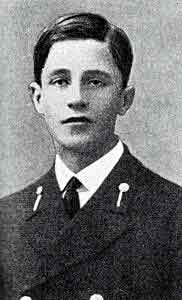
Midshipman Malleson awarded the Victoria Cross for his conduct as a crew member of the River Clyde at V Beach Cape Helles Gallipoli 25th April 1915
Of the Royal Navy personnel on the River Clyde Commander Unwin, Sub-Lieutenant Tisdall of Anson Battalion, Midshipmen Malleson and Drewry, Able Seamen Williams and Samson were awarded the Victoria Cross for their conduct in maintaining the landing facilities of the collier under the heaviest of rifle and machine gun fire at close range, while around them hundreds of soldiers were being hit, and assisting the wounded.
S Beach Landing:
The most easterly of the British landings at Cape Helles was against Tott’s Battery at the eastern end of Morto Bay.
The force of 2nd South Wales Borderers (less one company) under Lieutenant Colonel Casson, with engineers, signallers and a party of sailors commanded by the captain of HMS Cornwallis, landed from HMS Cornwallis at 7.30am.
The position was held by a platoon of Turkish troops. There was no wire.
Hampered again by the strong current the landing was behind schedule. Two companies in tows landed under fire from the Turkish platoon. The third company landed at the end of the point, scaled the cliff and were able to fire down on the Turkish position which was captured.
It was apparent that the main landing at V Beach was in considerable difficulty but Casson’s orders were to land and await the advance from Sedd el Bahr. He did not feel strong enough to move from the position captured and remained where he was. He did not know it but his battalion significantly outnumbered the Turkish troops holding V Beach.
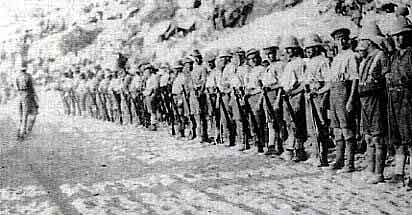
1st Royal Munster Fusiliers holding a roll call 18 days after the landing at V Beach Cape Helles on 25th April 1915: present were 5 officer and 372 men out of the battalion’s original strength of 25 officers and 900 men
Y Beach landing:
The landing at Y Beach, three miles up the coast north of X Beach, was intended to insert a flank attack to interfere with any Turkish attempt to reinforce its troops facing the main landings at Cape Helles.
The force comprised 2,000 men of 1st King’s Own Scottish Borderers, one company of 2nd South Wales Borderers and Plymouth Battalion Royal Marine Light Infantry. The force was commanded by Lieutenant Colonel Matthews the commanding officer of Plymouth Battalion.
The two borderers units were regulars while the Royal Marines were all war service enlisted and only partly trained.
The Gallipoli coast at this point was lined by high inaccessible cliffs, but with two river ravines breaking the cliff line at the point of landing.
The nearest Turkish troops to the landing point were two platoons a mile further south at the mouth of Gully Ravine. Other troops were five miles away.
There was confusion over the command for Y Beach, which was initially to be exercised by Brigadier General Hare, the commander of the covering force. At a late stage it was realised that Hare could hardly control all the landings and was restricted to X, W and V Beaches. Command was allowed to devolve on the senior officer at the other two beaches, Matthews at Y Beach, although there continued to be some uncertainty as Lieutenant Colonel Koe of the Scottish Borderers seems to have thought he was in command.
The force for Y Beach assembled off the coast, with the cruisers HMS Amethyst and Sapphire carrying the soldiers and Transport N2 the Plymouth Battalion, the cruiser HMS Dublin and battleship HMS Goliath and eight trawlers.
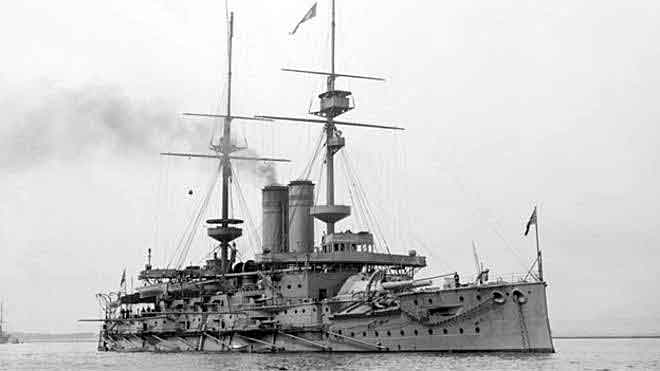
British pre-Dreadnought battleship HMS Goliath. Goliath supported the landing on Y Beach Gallipoli on 25th April 1915
Matthews’ instructions from General Hunter-Weston were that he was to move inland, capture a Turkish gun that was thought to be in the area and then draw attention to himself to divert any Turkish forces that might otherwise re-inforce the garrison facing the Cape Helles landings.
When the British main force advanced to a point level with Matthews’ troops he was to join the advance. The possibility of the main force stalling completely in the area of the landings was not covered by Matthews’ instructions.
At 4.15am four trawlers carrying troops and each towing six cutters steamed towards Y Beach. When the bombardment at Cape Helles began A and B Companies and the machine guns of 1st KOSB went ashore in the cutters. There was no opposition. There appeared to be no Turks in the area.
By 5.45am the whole force was ashore. Two KOSB companies moved inland to the edge of Gully Ravine, a deep feature that ran north to south parallel to the coast.
At 7.30am two companies of Royal Marines moved south-east across Gully Ravine in search of the Turkish gun.
At around 9am General Hamilton passed Y Beach in HMS Queen Elizabeth on his way from the Anzac landings to Cape Helles. The news of the unopposed landing at Y Beach and the lack of any Turkish troops in the area was signalled to Hamilton who saw the possibilities available of exploiting the landing at Y Beach with an advance inland in force.
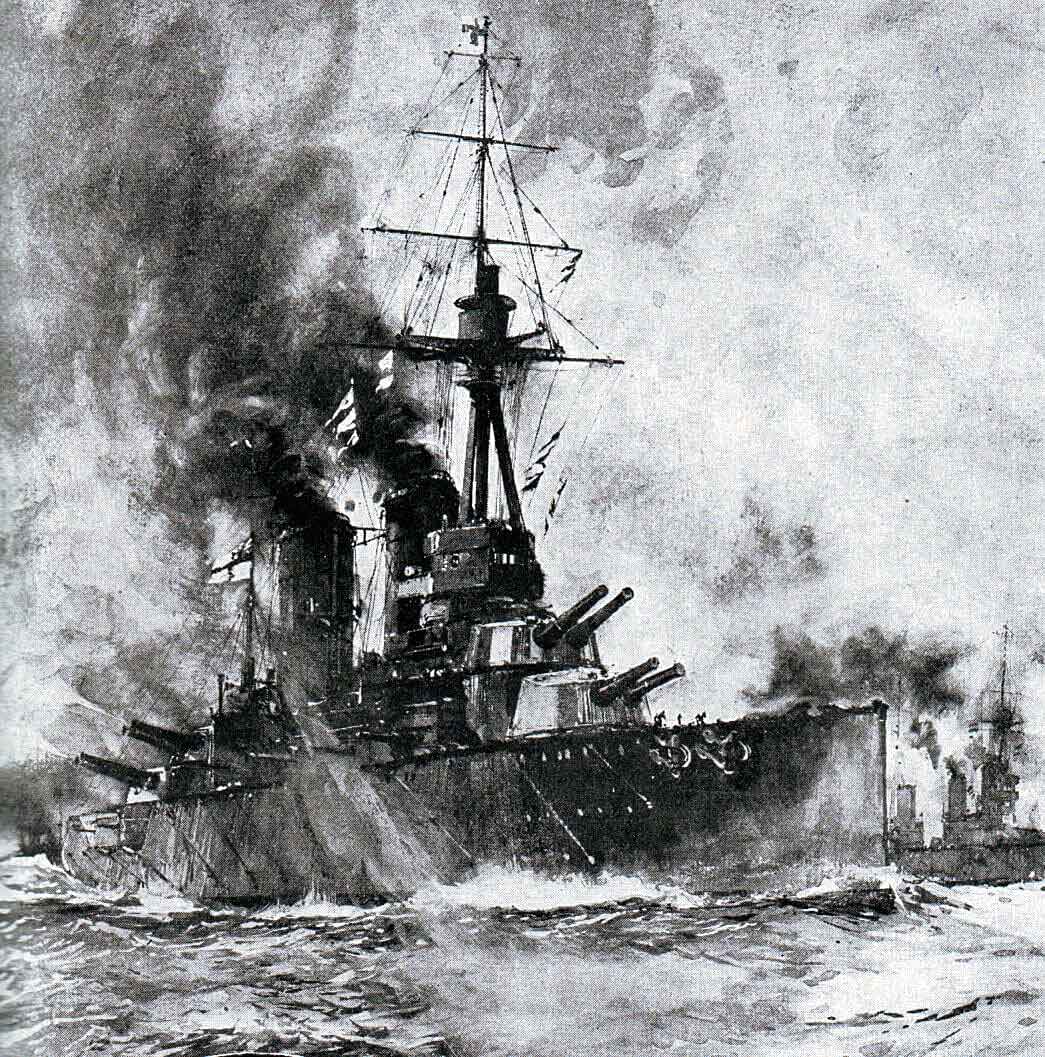
British Flag Ship, battleship HMS Queen Elizabeth. She carried both General Hamilton and Admiral de Robeck on the day of the landings at Anzac and Cape Helles on Gallipoli 25th April 1915
Hamilton at 9.21am signalled Hunter-Weston asking him if he would like to land some more men at Y Beach. At 10am Hamilton repeated the signal. Hunter-Weston replied that a diversion of troops would delay the main landing and the proposal lapsed.
The Official History states of the issue that Hunter-Weston still expected the Turkish resistance at Cape Helles to be overcome and Hamilton did not know enough of the situation to interfere with Hunter-Weston’s conduct of the battle.
This is an examples of Hamilton’s compliance with the conventions of command in the British Army, one of which is that a subordinate commander must be left to make his own decisions without interference from the commander-in-chief.
Until early afternoon the force remained at the Y Beach landing point doing little. The Royal Marines returned without finding the gun. Colonel Matthews and his adjutant crossed the Gully Ravine and walked nearly to the village of Krithia without seeing any Turkish troops. The two Turkish companies in the area had already moved south to Cape Helles.
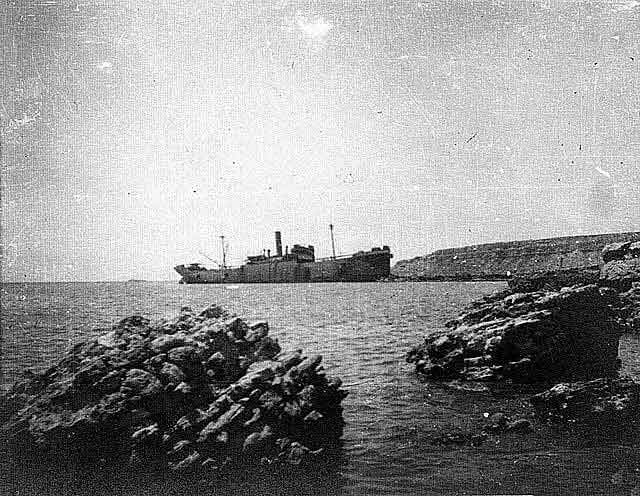
River Clyde used as a landing ship at V Beach Cape Helles Gallipoli on 25th April 1915 seen later in the campaign
During the afternoon Matthews moved his force from the beach area onto the cliff top where a defensive position was prepared in anticipation of the Turkish attacks to come. Nothing else was done.
The 2,000 British troops landed at Y Beach outnumbered the whole of the Turkish garrison in the south of Gallipoli. If a senior officer of energy and resource had been given command of the Y Beach force once it was removed from Brigadier General Hare’s remit the opportunity available for the force might have been exploited.
The author of the Official History who was on General Hamilton’s staff at Gallipoli makes it clear that in his view Casson on S Beach and Matthews on Y Beach had the opportunity to retrieve the disastrous failure at V Beach.
The landing operations continued on 26th April 1915.
References for the Gallipoli Landings:
Times History of the First World War
Official History of Military Operations in Gallipoli by Brigadier Aspinall-Oglander
‘Mr Midshipman VC’: biography of Midshipman George Drewry, winner of the Victoria Cross during the landings from the River Clyde on 25th April 1915 at Gallipoli; written by Quentin Falk and published by Pen and Sword Maritime in 2018.
The previous battle of the First World War is Gallipoli Part III: ANZAC landing on 25th April 1915
The next battle of the First World War is Battle of Jutland Part I: Opposing fleets
